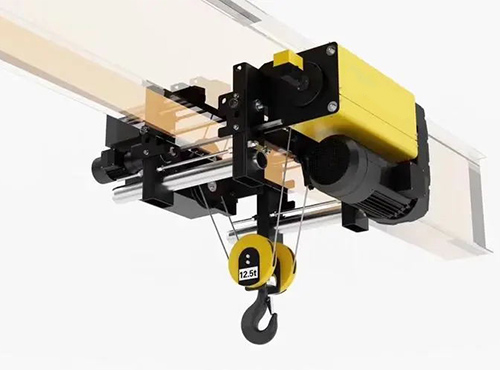How does an electric wire rope hoist work? First, we need to know what the electric wire rope hoist is. Electric wire rope hoist stands as a tool in material handling equipment, changing various industries with its efficiency and precision. Huadelift electric wire rope hoists can be applied in different industries with their high quality.
Electric wire rope hoist is composed of a powerful electric motor, a sturdy steel rope, and a sophisticated control system. At its core, the electric motor, typically mounted on a durable frame, generates the force needed to lift and lower the load. This force is transmitted through a high-strength steel rope, wound around a drum or a sheave. This operation process ensures the safety of electric wire rope hoist work.


Electric motor
The electric wire rope hoist comprises several integral components to facilitate efficient material handling. At its core is the electric motor, which is positioned within a durable frame, providing the necessary strength to lift and lower heavy loads.
High-strength steel rope
Connected to the electric motor is the high-strength steel rope, a critical element responsible for bearing the load. Wound around a drum or sheave, the steel rope serves as the conduit through which the force generated by the motor is transmitted to the suspended load.
Control system
An essential feature of the electric wire rope hoist is its control system. This sophisticated mechanism allows for precise manipulation of the hoist, offering operators the ability to manage the lifting and lowering processes with accuracy.
Sturdy hook / lifting attachment
The electric wire rope hoist often incorporates a sturdy hook or lifting attachment, providing a secure point for connecting with the load. Safety features such as limit switches and overload protection mechanisms further reinforce the reliability of the electric hoist.
Safety Mechanisms
Electric hoists are equipped with safety features such as limit switches, overload protection, and emergency braking systems. These mechanisms enhance operator safety and protect the equipment from potential damage during operation.
Versatility
These hoists are designed to accommodate a wide range of applications across diverse industries. Their adaptability makes them suitable for lifting and moving heavy materials in manufacturing, construction, and warehousing environments.
Durable Construction
The hoist is constructed with durability in mind, often featuring a sturdy frame and components made from high-quality materials. This robust construction ensures a long service life and reliable performance under demanding conditions.
Ease of Maintenance
Many electric wire rope hoists are designed with ease of maintenance in mind, allowing for straightforward inspections and repairs. This feature minimizes downtime and contributes to the overall cost-effectiveness of the equipment.


In essence, the electric wire rope hoist operates on the principles of converting electrical energy into mechanical force, utilizing a durable steel rope to lift and lower loads with precision. As the rubber tired gantry crane or other lifting equipment, the integration of control systems and safety features enhances the hoist’s efficiency and ensures safe and reliable material handling in various industrial applications. Here are steps how does an electric wire rope hoist work:
Step 1: Electric Motor Activation
The process begins with the activation of the electric motor, a powerful component housed within the hoist. This motor is typically electrically powered and generates the mechanical force required for lifting.
Step 2: Transmission of Power
The mechanical force generated by the electric motor is transmitted to the high-strength steel rope. The motor’s rotational energy is transferred to the rope, which is wound around a drum or sheave.
Step 3: Steel Rope Winding
The steel rope, often made from durable materials and designed to withstand heavy loads, is wound around the drum or sheave. This winding action occurs as the electric motor continues to operate, creating tension in the rope.
Step 4: Lifting and Lowering
As the electric motor continues to operate, the wound steel rope exerts force on the load, causing it to be lifted. The control system, like limit switches, enables precise manipulation of the lifting process. Conversely, to lower the load, the motor’s operation is adjusted accordingly.
Step 5: Emergency Braking
In the event of an emergency or power failure, electric wire rope hoists often feature emergency braking systems. These systems are designed to bring the load to a controlled stop, preventing accidents and ensuring the safety of both the load and the equipment.
If you want to know more information about electric wire rope hoist, you can contact us directly. In addition, electric wire rope hoist is the part of lifting equipment. If you are looking for a suitable electric hoist for your gantry crane or other lifting equipment, contact us now!